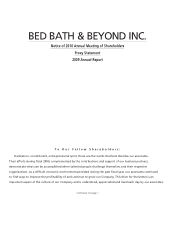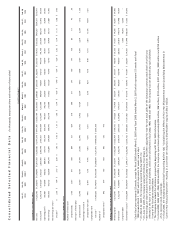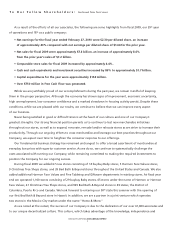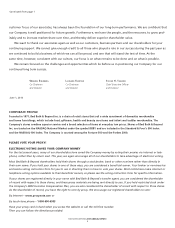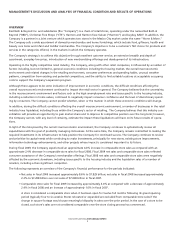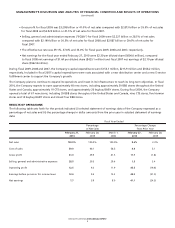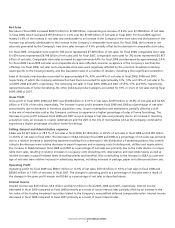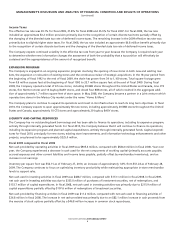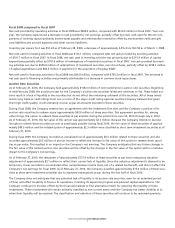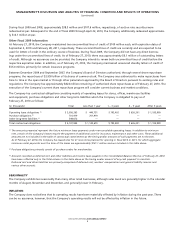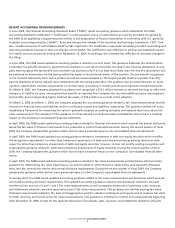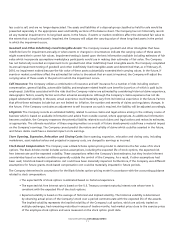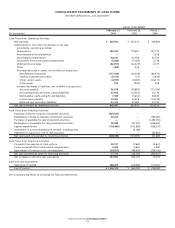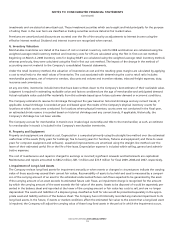Bed, Bath and Beyond 2009 Annual Report Download - page 11
Download and view the complete annual report
Please find page 11 of the 2009 Bed, Bath and Beyond annual report below. You can navigate through the pages in the report by either clicking on the pages listed below, or by using the keyword search tool below to find specific information within the annual report.BED BATH & BEYOND 2009 ANNUAL REPORT
9
RECENT ACCOUNTING PRONOUNCEMENTS
In June 2009, the Financial Accounting Standards Board (“FASB”) issued accounting guidance which established the FASB
Accounting Standards Codification (“Codification”) as the exclusive source of authoritative accounting principles recognized by
the FASB to be applied by nongovernmental entities in the preparation of financial statements in conformity with U.S. generally
accepted accounting principles (“GAAP”). Rules and interpretive releases of the Securities and Exchange Commission (“SEC”) are
also considered sources of authoritative GAAP for SEC registrants. The Codification supersedes all existing non-SEC accounting and
reporting standards, however it does not change current GAAP. The Codification was effective for all financial statements issued
for interim and annual periods ending after September 15, 2009. Accordingly, the Company has reflected all necessary changes in
this filing.
In June 2006, the FASB issued updated accounting guidance related to income taxes. This guidance addresses the determination
of whether tax benefits claimed or expected to be claimed on a tax return should be recorded in the financial statements. A com-
pany may recognize the tax benefit from uncertain tax positions only if it is at least more likely than not that the tax position will
be sustained on examination by the taxing authorities based on the technical merits of the position. The tax benefits recognized
in the financial statements from such a position should be measured based on the largest benefit that has a greater than fifty
percent likelihood of being realized upon settlement with the taxing authorities. This guidance also provided direction on derec-
ognition, classification, interest and penalties on income taxes, accounting in interim periods and required increased disclosures.
On March 4, 2007, the Company adopted this guidance and recognized a $13.1 million increase to retained earnings to reflect the
change to its liability for gross unrecognized tax benefits as required. The Company also recorded additional gross unrecognized
tax benefits, and corresponding higher deferred tax assets, of $35.6 million as a result of the adoption.
On March 2, 2008 and March 1, 2009, the Company adopted the accounting guidance related to fair value measurements and dis-
closures for financial assets and liabilities and for non-financial assets and liabilities, respectively. This guidance defines fair value,
establishes a framework for measuring fair value in generally accepted accounting principles and expands disclosures about fair
value measurements. The adoption of this guidance for financial and non-financial assets and liabilities did not have a material
impact on the Company’s consolidated financial statements.
In April 2009, the FASB issued updated accounting guidance related to financial instruments which requires the annual disclosures
about the fair value of financial instruments to be presented in interim financial statements. During the second quarter of fiscal
2009, the Company adopted this guidance which did not have a material impact on its consolidated financial statements.
In April 2009, the FASB issued updated accounting guidance related to investments in debt and equity securities which modifies
the recognition requirements for other-than-temporary impairments of debt securities and enhances existing disclosures with
respect to other-than-temporary impairments of debt and equity securities, however, it does not modify existing recognition and
measurement guidance related to other-than-temporary impairments of equity securities. During the second quarter of fiscal
2009, the Company adopted this guidance which did not have a material impact on the Company’s consolidated financial state-
ments.
In April 2009, the FASB issued updated accounting guidance related to fair value measurements and disclosures which provides
guidance for determining fair value when there is no active market or where the price inputs being used represent distressed
sales, and also amends the interim and annual disclosure requirements. During the second quarter of fiscal 2009, the Company
adopted this guidance which did not have a material impact on the Company’s consolidated financial statements.
In January 2010, the FASB issued updated accounting guidance related to fair value measurements and disclosures which amends
and clarifies existing disclosure requirements. This updated accounting guidance requires new disclosures related to amounts
transferred into and out of Level 1 and 2 fair value measurements as well as separate disclosures of purchases, sales, issuances,
and settlements related to amounts reported as Level 3 fair value measurements. This guidance also clarifies existing fair value
disclosure requirements related to the level of disaggregation and the valuation techniques and inputs used to measure fair value
for both recurring and nonrecurring fair value measurements. This guidance is effective for interim and annual periods beginning
after December 15, 2009, except for the separate disclosures of purchases, sales, issuances, and settlements related to amounts

